翻译的八种技巧
翻译常用的八种技巧
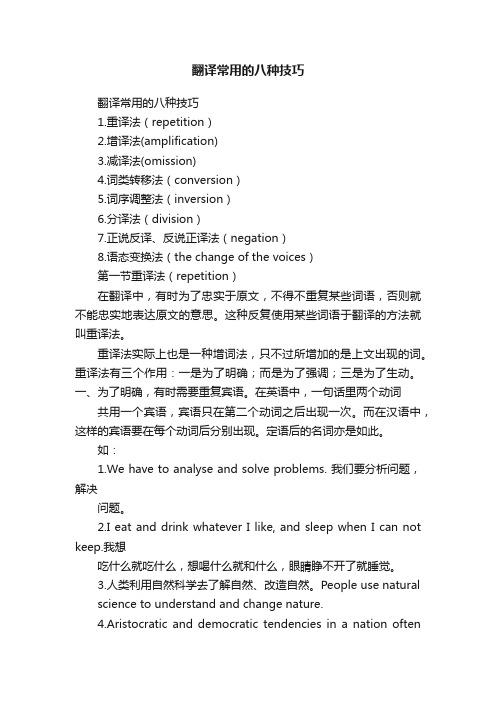
翻译常用的八种技巧翻译常用的八种技巧1.重译法(repetition)2.增译法(amplification)3.减译法(omission)4.词类转移法(conversion)5.词序调整法(inversion)6.分译法(division)7.正说反译、反说正译法(negation)8.语态变换法(the change of the voices)第一节重译法(repetition)在翻译中,有时为了忠实于原文,不得不重复某些词语,否则就不能忠实地表达原文的意思。
这种反复使用某些词语于翻译的方法就叫重译法。
重译法实际上也是一种增词法,只不过所增加的是上文出现的词。
重译法有三个作用:一是为了明确;而是为了强调;三是为了生动。
一、为了明确,有时需要重复宾语。
在英语中,一句话里两个动词共用一个宾语,宾语只在第二个动词之后出现一次。
而在汉语中,这样的宾语要在每个动词后分别出现。
定语后的名词亦是如此。
如:1.We have to analyse and solve problems. 我们要分析问题,解决问题。
2.I eat and drink whatever I like, and sleep when I can not keep.我想吃什么就吃什么,想喝什么就和什么,眼睛睁不开了就睡觉。
3.人类利用自然科学去了解自然、改造自然。
People use naturalscience to understand and change nature.4.Aristocratic and democratic tendencies in a nation oftenshowthemselves in its speech.民族的贵族倾向和民族倾向常在其言语中表现出来。
5.我们来修改安全规则和卫生规则吧。
Let’s revise our safety andsanitary regulations.二、英语常用省略,但为了明确,也为了强调某些内容,在汉语中常常要将省去的部分重译出来。
翻译讲座3:英译汉的技巧
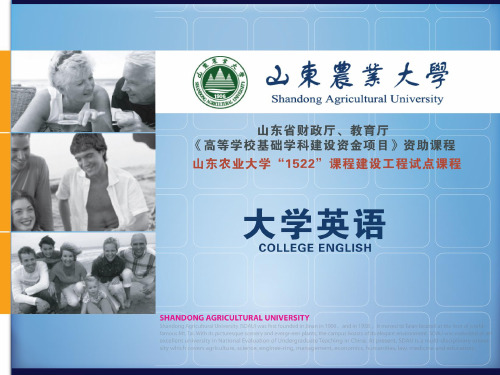
• 6. “What America has lost,” says one veteran observer, “is
第二节 增译法
7. Inflation has now reached unprecedented level. 目前通货膨胀已经发展到空前严重的地步。 (形容词)
8. A fool and his words are soon parted; a man of genius and his money. (并列句中省略的部分)
第三节 减译法
1.Whether the laws are good or bad, they cannot complain, they cannot question, they cannot suggest changes.(作主语的人称代词) 无论法律公正与否,他们无法抱怨、无法质疑、无法建议 修改。 2. He who never reached the Great Wall is not a true man. (表示泛指的人称代词) (物主代词、做宾语的人称代词也可省略)
愚人会很快忘记说过的话,智者会很快放弃手里的钱。 蠢材轻其言,天才轻其财。
第二节 增译法
9. The high-altitude plane was and still is a remarkable bird. (表示时态的词) 该高空飞机过去是,现在仍然是... … 10. A red sun rose slowly from the calm sea. (量词)
第三节 减译法
3. Insufficient power made it difficult to start the motor. (先行代词it) 电力不足,难以使马达启动。 4. Reading furnishes the mind only with materials of knowledge; it is thinking that makes what we read ours. (强调句型中的it) 读书只能给大脑提供知识的材料, 思考才能把我们所读的东西变成自己 的。
英汉互译八种技巧

注意事项
保持原文的语义和语法正确
在直译过程中,要确保译文准确地传达了原文的语义和语法,避 免出现歧义或误解。
尊重原文的文化特色
直译法要尊重原文的文化特色,尽可能保留原文的文化信息,避免 因文化差异而引起的误解。
符合目标语言的表达习惯
尽管直译法强调保持原文的形式,但译文仍需符合目标语言的表达 习惯,以使读者能够更好地理解和接受。
注意事项
准确理解原文
在运用直译与意译结合法时,首 先要准确理解原文的意思,避免
因理解错误而导致翻译错误。
灵活调整词序
在直译与意译结合的过程中,需 要根据汉语的表达习惯灵活调整 英文原句的词序,使译文更加自
然流畅。
保持原文风格
在翻译过程中,要尽量保持原文 的风格和语言特色,如比喻、修 辞等,以使译文更加贴近原文。
注意事项
加注应当符合目标语言的表达习惯和规范,避免出现 语法错误或表达不当的情况。
加注应当简洁明了,避免过多的解释和说明,以免影 响读者的阅读体验。
加注应当尽可能地保留原文的信息和意义,避免出现 信息丢失或误解的情况。
THANKS FOR WATCHING
感谢您的观看
文的含义。
符合目标语言习惯
意译法要求译文符合目标语言的表 达习惯和语法规则,避免出现生硬 或不符合规范的语言表达。
保持原意不变
意译法的核心是保持原文意思不变, 因此在翻译过程中要特别注意保持 原意的完整性和准确性,避免出现 信息的遗漏或误解。
04
音意结合法
定义
• 音意结合法是指在进行英汉互译 时,将英文的发音和汉语的意义 结合起来,以达到准确传达原文 意思的目的。
和文化背景。
适用范围
当源语言与目标语言存在较大 的文化差异和语言结构差异时, 归化法可以发挥很好的作用。
英文翻中文的八大翻译技巧
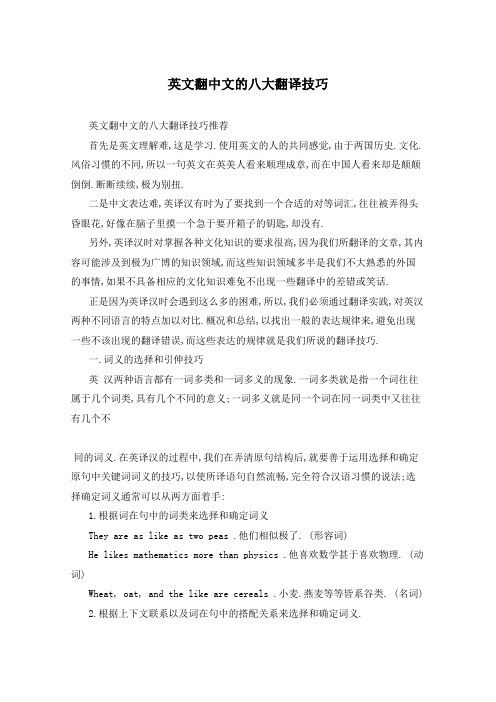
英文翻中文的八大翻译技巧英文翻中文的八大翻译技巧推荐首先是英文理解难,这是学习.使用英文的人的共同感觉,由于两国历史.文化.风俗习惯的不同,所以一句英文在英美人看来顺理成章,而在中国人看来却是颠颠倒倒.断断续续,极为别扭.二是中文表达难,英译汉有时为了要找到一个合适的对等词汇,往往被弄得头昏眼花,好像在脑子里摸一个急于要开箱子的钥匙,却没有.另外,英译汉时对掌握各种文化知识的要求很高,因为我们所翻译的文章,其内容可能涉及到极为广博的知识领域,而这些知识领域多半是我们不大熟悉的外国的事情,如果不具备相应的文化知识难免不出现一些翻译中的差错或笑话.正是因为英译汉时会遇到这么多的困难,所以,我们必须通过翻译实践,对英汉两种不同语言的特点加以对比.概况和总结,以找出一般的表达规律来,避免出现一些不该出现的翻译错误,而这些表达的规律就是我们所说的翻译技巧.一.词义的选择和引伸技巧英汉两种语言都有一词多类和一词多义的现象.一词多类就是指一个词往往属于几个词类,具有几个不同的意义;一词多义就是同一个词在同一词类中又往往有几个不同的词义.在英译汉的过程中,我们在弄清原句结构后,就要善于运用选择和确定原句中关键词词义的技巧,以使所译语句自然流畅,完全符合汉语习惯的说法;选择确定词义通常可以从两方面着手:1.根据词在句中的词类来选择和确定词义They are as like as two peas .他们相似极了. (形容词)He likes mathematics more than physics .他喜欢数学甚于喜欢物理. (动词)Wheat, oat, and the like are cereals .小麦.燕麦等等皆系谷类. (名词) 2.根据上下文联系以及词在句中的搭配关系来选择和确定词义.He is the last man to come .他是最后来的.He is the last person for such a job .他最不配干这个工作.He should be the last man to blame.怎么也不该怪他.This is the last place where I e_pected to meet you .我怎么也没料到会在这个地方见到你.词义引伸是我们英译汉时常用的技巧之一.翻译时,有时会遇到某些词在英语辞典上找不到适当的词义,如果任意硬套或逐词死译,就会使译文生硬晦涩,不能确切表达原意,甚至会造成误解.这时就应根据上下文和逻辑关系,从该词的根本含义出发,进一步加以引伸,引伸时,往往可以从三个方面来加以考虑.1.词义转译.当我们遇到一些无法直译或不宜直译的词或词组时,应根据上下文和逻辑关系,引伸转译.The energy of the sun comes to the earth mainly as light and heat.太阳能主要以光和热的形式传到地球.2.词义具体化.根据汉语的表达习惯,把原文中某些词义较笼统的词引伸为词义较具体的词.The last stage went higher and took the Apollo into orbit round theearth.最后一级火箭升得更高,把〝阿波罗号〞送进围绕地球运行的轨道.3.词义抽象化.根据汉语的表达习惯,把原文中某些词义较具体的词引伸为词义较抽象的词,或把词义较形象的词引伸为词义较一般的词.Every life has its roses and thorns .每个人的生活都有甜有苦.二.词类转译技巧在英译汉过程中,有些句子可以逐词对译,有些句子则由于英汉两种语言的表达方式不同,就不能逐词对译,只能将词类进行转译之后,方可使译文显得通顺.自然;对词类转译技巧的运用须从四个方面加以注意.1.转译成动词.英语中的某些名词.介词.副词,翻译时可转译成汉语中的动词. The lack of any special e_cretory system is e_plained in a similar way.植物没有专门的排泄系统,可用同样的方式加以说明. (名词转译)As he ran out ,he forgot to have his shoes on .他跑出去时,忘记了穿鞋子.2.转译成名词.英语中的某些动词.形容词,翻译时可转换成汉语中的名词.The earth on which we live is shaped a ball.我们居住的地球,形状像一个大球. (动词转译)The tor did his best to cure the sick and the wounded .医生尽了最大的努力来治疗病号和伤员. (形容词转换)3.转译成形容词.英语中有些作表语或宾语的抽象名词,以及某些形容词派生的名词,往往可转译成汉语中的形容词.另外,当英语动词转译成汉语名词时,原来修饰该动词的副词也往往随之转译成汉语中的形容词.It is no use employing radar to detect objects in water.使用雷达探测水下目标是没有用的. (作表语的名词转译)The sun affects tremendously both the mind and body of a man .太阳对人的身体和精神都有极大的影响. (副词转译)4.转译成副词.英语中的某些名词.形容词,翻译时可转译成汉语中的副词.When he catches a glimpse of a potential antagonist, his instinct is to winhim over with charm and humor .只要一发现有可能反对他的人,他就本能地要用他的魅力和风趣将这些人争取过来. (名词转译)三.汉译的增词技巧英译汉时,按意义上.修辞上或句法上的需要加一些词,使译文更加忠实通顺地表达原文的思想内容;但是,增加的并不是无中生有,而是要增加原文中虽无其词却有其意的一些词,这是英译汉中常用的的技巧之一.增词技巧一般分作两种情况.1.根据意义上或修辞上的需要,可增加下列七类词.Flowers bloom all over the yard .朵朵鲜花满院盛开. (增加表示名词复数的词)After the banquets ,the concerts and the table tennis e_hibitor ,he wenthome tiredly .在参加宴会.出席音乐会.观看乒乓球表演之后,他疲倦地回到了家里. (增加动词)He sank down with his face in his hands .他两手蒙着脸,一屁股坐了下去. (增加副词)I had known two great social systems .那是以前,他就经历过两大社会制度. (增加表达时态的词)As for me ,I didn’t agree from the very beginning .我呢,从一开始就不赞成.(增加语气助词)The article summed up the new achievements made in electronic computers,artificial satellites and rockets .本文总结了电子计算机.人造卫星和火箭这三方面的新成就. (增加概括词)2.根据句法上的需要增补一此词汇.Reading makes a full man ;conference a ready man ;writing an e_act man.读书使人充实,讨论使人机智,写作使人准确.(增补原文句子中所省略的动词) All bodies on the earth are known to possess weight.大家都知道地球上的一切物质都肯有重量. (增补被动句中泛指性的词)四.正反.反正汉译技巧正反.反正汉译技巧是指翻译时突破原文的形式,采用变换语气的办法处理词句,把肯定的译成否定的,把否定的译成肯定的.运用这种技巧可以使译文更加合乎汉语规范或修辞要求,且不失原意.这种技巧可分五个方面加以陈述.1.肯定译否定The above facts insist on the following conclusions .上述事实使人们不能不得出以下结论.2.否定译肯定She won’t go away until you promise to help her .她要等你答应帮助以后才肯走.3.双否定译肯定There can be no sunshine without shadow有阳光就有阴影.但是,如果翻译时保留英语原来的〝否定之否定〞的形式并不影响中文的流畅时,则应保留的目的还可突出原文中婉转的语气.如He is not unequalto the duty .他并非不称职.4.正反移位I don’t think he will come .我认为他不会来了.5.译为部分否定Not all minerals come from mines .并非所有矿物都来自矿山.Both of the substances do not dissolve in water.不是两种物质都溶于水.五.汉译的重复技巧重复技巧是英译汉中的一种必不可少的翻译技巧.由于英译汉时往往需要重复原文中的某些词才能使译文表达明确具体;又由于英汉语言结构不同,重复的手段和作用也往往不尽相同,大致可分为三种.1.为了明确I had e_perienced o_ygen and /or engine trouble.我曾碰到过,不是氧气设备了故障,就是引擎出故障,或两者都出故障(重复名词)Under ordinary conditions of pressure ,water becomes ice at C and steamat100C.在常压下,水在摄氏零度时变成冰,在摄氏一百度时变成蒸汽. (重复动词)A locality has its own over-all interest ,a nation has another and theearth get another.一个地方有一个地方的全局,一个国家有一个国家的全局,一个地球有一个地球的全局(重复谓语部分)2.为了强调He wandered along the street ,thinking and thinking brooding andbrooding.他在街头游来荡去,想了又想,盘算了又盘算.3.为了生动While stars and nebulae look like specks or small patches of light . theyare really enormous bodies.星星和星云看起来只是斑点点,或者是小片的光,但它们确实是巨大的天体.六.倒译技巧英汉词句组成和排列的顺序千差万别,因此英译汉时作些调整,颠倒一下顺序,则是一种极为常见的翻译技巧,这种翻译技巧共分五种类型.1.复合句倒译技巧.复合句倒译可分为部分倒译和完全倒译两种技巧.This university 6 newly _established faculties ,namely .Electronic Computer,High Energy Physics ,Laser ,Geo-physics ,Remote Sensing, and GeneticEngineering.这所大学现在有电子计算机.高能物理.激光.地球.物理.遥感技术.遗传工程等六个新建的专业. (部分倒译)Many laws of nature actually e_ist in nature though they have not yet beendiscovered.虽然许多自然规律还没被发现,但是它们确实在自然界中存在. (完全倒译)2.被动句倒译的技巧.被动句倒译时,有时可将被动句倒译成主动句,有时可将状语倒译成主语.The structure of an atom can be accurately described though we cannot seeit.虽然我们看不见原子结构,但能准确地描述它. (被动句倒译成主动句)Table tennis is played all over China .中国到处都打乒乓球. (状语倒译成主语)3.以否定型副词或条件副词开头的句子的部分倒译技巧.能引起这种倒译的副词有no ,never ,hardly ,no longer . in noway ,not until ,not even ,only等.Never before have I read such an interesting book .我从来没有读过这样有趣的书.4.带有介词短语句子的部分倒译技巧These date will be of some value in our research work .这些资料对于我们的研究工作有些价值.5.习语的倒译技巧.习语的倒译可分为按照汉语的固定顺序倒译和从轻重上加以区分进行倒译以及逆时间顺序进行倒译三种技巧.For its last 600 miles the Yellow River flows eastwards through the flat ,fertile ,North China Plain ,which is densely populated.黄河最后的六百英里,向东流过平坦肥沃.人口密集的华北平原. (按照汉语的固定顺序倒译)Heal the wounded ,rescue the dying ,practice revolutionaryhumanitarianism.救死扶伤,实行革命的人道主义. (以轻重上区分进行倒译)We have to be quick of eye and deft of hand .我们必须眼疾手快. (逆时间顺序倒译)七.句子成份的转译技巧英汉两种语言,由于表达方式不尽相同,在具体英译汉时,有时往往需要转换一下句子成分,才能使译达到逻辑正确.通顺流畅.重点突出等目的.句子成分转译作为翻译的一种技巧,其内容和形式都比较丰富,运用范围也相当广泛,共包括五个方面的内容.1.主语转译技巧,可以将句子的主语转译成汉语中的定语.宾语.状语等.The wings are responsible for keeping the sir plane in the air.机翼的用途是使飞机在空中保持不坠. (转译成定语)To get all the stages off the ground ,a first big push is needed.为了使火箭各级全部离开地面,需要有一个巨大的第一次推力. (转译成宾语) Machinery has made the products of manufactories very much cheaper thanformerly.因为机械的缘故,工厂里出的产品比起以前来,价格便宜多了. (转译成状语)2.谓语转译技巧.可以将谓语转译成定语.Radar works in very much the same way as the flashlight.雷达的工作原理和手电筒极为相同.3.宾语转译技巧.可以将宾语转译成主语.Automatic lathes perform basically similar functions but apper in avaritety of forms.各种自动车床的作用基本相同,但形式不同4.定语转译技巧.定语可以转译成谓语和状语.Neutron has a mass slightly larger than that of proton.中子的质量略大于质子的质量. (转译成谓语)Scientists in that county are now supplied with necessarybooks ,epuipmentand assistant ,that will ensure success in their scientific research.现在已给该县科学家提供了必要的图书.仪器和助手,以保证科研工作的成功. (转译成状语)5.状语转译技巧.状语转译一般指的是状语从句的转译.它可分作把时间状语从句转译成条件状语从句,把地点状语从转译成条件状语从句和把原因状语从句转译成困果偏正复句中的主语等三种形式.These three colors ,red ,green ,and violet ,when combined ,produced white.红色.绿色和紫色这三种颜色如果合在一起就变成白色. (时间状语从句转译成条件状语从句)Where there is nothing in the path of beam of light ,nothing is seen.如果光束通道上没有东西,就什么也看不到. (地点状语从句转译成条件状语从句)Because he was convinced of the accuracy of this fact, he stuck to hisopinion.他深信这件事正确可靠,因此坚持已见. (原因状语从句转译成因果偏正复合句中的主句)八.分句.合句汉译技巧英译汉时,由于两种语言的句子结构大不相同而往往需要改变一下句子结构以适应于汉语的表达习惯.采用分句.合句进行翻译的作法正是为了达到这种目的而运用的一种重要技巧.所谓分句,就是指把原文的一个简单句译成两个或两个以上的句子;所谓合名,就是指把原文的两个或两个以上的简单句或一个复合句译成一个单句.运用这种分句.合句的汉译技巧可以使译文层次分明,更合乎于汉语的表达习惯.分句流译的技巧共分五种类型,合句汉译的技巧共分三种类型.先谈谈分句汉译技巧的五种类型.1.主语分句汉译技巧.A man spending twelve days on the moon would find ,on returning to theearth ,that a year had passed by already.一个人如果在月亮上度过了十二天,回到地球以后就会发现一年已经过去了.2.谓语分句汉译技巧.It goes without saying that o_ygen is the most active element in theatmosphere.不言而喻,氧气是大气中最活泼的元素.3.定语分句汉译技巧He managed to raise a crop of 200 miracle tomatoes that weighed up to twopounds each.他居然种出了二百个奇迹般的西红柿,每个重达两磅.4.状语分句汉译技巧Sunrays filtered in wherever they could ,driving out darkness and chokingthe shadows.阳光射入了它所能透过的地方,赶走了黑暗,驱散了幽影.5.同位语分句汉译技巧.Mary normally a timid girl ,argued heated with them about it.玛丽平常是个腼腆的姑娘,现在也热烈地和他们辩论起来._年翻译资格考试三级口译模拟题1. The average age of people in the countryside is increasing, while thatof the cities is falling. More old people stay in the countryside than youngpeople and the opposite is true in the cities.译文:农村人口的平均年龄正处于上升趋势,而在城市却正好相反.原因是在农村老年人要比年轻人多,城市正好相反.解析:本句难度适中,只需要按照句子的逻辑顺序将句子信息陈列出来即可.此外,本句无明显生词.2. One important reason for the move to cities has to do with quality oflife issues: comfort and convenience. For e_ample, most of us would like ourchildren to receive the better education, and cities often offer betterschools.译文:〝进城热〞与生活水平问题息息相关.人们向往城市舒适方便的生活.就像我们大部分人都想子女能够接收到更好的教育,而城市通常就有教育质量更好的学校.解析:在做本句翻译时需要注意在前半句适当地增译一些信息,如在comfort and convenience 处需要加上move to thecities的主语〝人们〞.后半句难度不大,直译即可.3. Most burglars are opportunist, looking for an easier break-in. So don’tmake things simply for them. Don’t advertise the fact that you are out or away,or be careless about security.译文:大部分的窃贼都是投机分子,他们会寻找最方便快捷的〝翻.墙入室〞的机会.所以不要给他们可乘之机.不要嚷嚷着让别人都知道你不在家,也不要太精选大意而忽略了安全问题.解析:本句句型不复杂,需要注意几个词语的译法,如opportunist本来是〝机会主义者〞,在这里用于形容burglars身上,需要相应地翻译成贬义词〝投机分子〞;此外,don’tmake things simply for them可以用成语〝可乘之机〞概括,这些需要同学平时多做翻译练习积累,在会在临考时马上反应出来.4. Researchers from the University of Copenhagen and the University ofIceland said ash particles from the early part of the volcanic eruption areespecially abrasive, posing a possible threat to aircraft engines.译文:来自哥本哈根大学和冰岛大学的研究者们表示早些时候火山爆发遗留的火山灰摩擦度非常高.这可能对飞机的引擎产生威胁.解析:本句句型简单,但生词较多,需要考生抓注意些重点词汇理解.如:volcanic eruption 是表示〝火山爆发〞, abrasive表示〝磨损的〞.考生在遇到不会的单词时也不用过于慌张,一般句子中包含大量专业词汇句意都比较简单,可凭上下文进行推测.5. Lack of sanitation leads to wide spread of contamination of drinkingwater. Recent statistics say water-associated infectious diseases claim up to3.2million lives each year, appro_imately 6 percent all death globally.译文:不注意环境卫生会导致饮用水大规模受污染.近期的数据显示与饮用水有关的可传染性疾病每年可导致320万人失去生命,这个数字接近每年全球死亡人数的6%.解析:本句的主题是高口中常考的环境问题,全句无复杂结构,考生需要保证数字听译的准确性.本句中有出现两处数字,要求考生掌握数字速记的方法.contamination :污染infectious :传染的,有传染性的appro_imately :大约_年翻译资格考试三级口译模拟题The term 〝American dream〞 is widely used today. But what e_actly does thisconcept mean? Where does the term come from? Has the meaning of the term changedover time? Questions like these can complicate a seemingly simple term and leadus to an even more important question: is the American dream a myth or a realitytoday?The term 〝American dream〞 began to be widely used in _67. The term wasused in a famous novel written by Horatio Alger. The novel, Ragged Dick, was a〝rags to riches〞 story about a little boy who was orphaned and lived in NewYork. The boy saved all his pennies, worked very hard, and eventually becamerich. The novel sent the message to the American public that anyone couldsucceed in America if they were honest, worked hard, and showed determination tosucceed. No matter what your background, no matter where you were from, nomatter if you had no money or no family, hard work and perseverance would alwayslead to success.Today, the message from Alger’s novel is still a prevalent one in thiscountry. It is still used to define the American dream. A very basic definitionof the American dream is that it is the hope of the American people to have abetter quality of life and a higher standard of living than their parents. Thiscan mean that each generation hopes for better jobs, or more financial security,or ownership of land or a home.However, new versions and variations of the American dream have surfacedsince Alger’s novel was published. For one thing, the basic definitionI stateda moment ago —the idea that Americans are always seeking to improve theirlifestyle — also suggests that each generation wants more than the previousgeneration had. Some people would argue that this ever-increasing desire toimprove the quality of one’s life may have started out on a smaller scale in thepast, but today has led to an out-of-control consumerism and materialism. Another more benign view of the American dream is that it is about thedesire to create opportunities for ourselves, usually through hard work.Ahallmark of the American dream, some would argue, is the classic〝self-starter,〞the person who starts out with very little in life—little money, few friends,few opportunities—and works hard to make his or her way in the world. A classice_ample of this type of American dreamer would be former president AbrahamLincoln, who was born in a log cabin, was largely self-educated, and yet workedhis way up in the world to eventually become a United States president. This view of the American dream has also been associated with immigrantsand their quests for a better life in a new country. Americans have long beenfascinated by immigrant stories, and many feel great pride about their ownfamilies who may have come from other countries, worked very hard, and created abetter life for future generations.The American dream has also, historically, been associated with westwarde_pansion in this country. Throughout most of the _00s, the notion of thefrontier—a vast e_panse of largely unclaimed land in the West—symbolized newopportunities and a fresh start to people. Many a dreamer set off for the Westin search of land, jobs, gold, or other opportunities, often with ne_t tonothing in his pocket. Unfortunately, this idea of new opportunities in the Westhad a negative side.The American West was not unpopulated; Native American Indians already lived there, along with other immigrant groups, and these people were oftendisplaced — or met with violence — if they interfered with the visions or ideasof westward-migrating Americans.A more recent interpretation of the American dream has to do with equality.Civil rights activists such as Dr. Martin Luther King Junior, used some of therhetoric associated with the American dream to urge people to work for equalopportunities for all Americans, not just some Americans. A harsh reality wasbecoming clear to some people, especially in the _60s and _70s: not everyone had the same opportunities. If people were denied jobs, education, or otheropportunities because of their race, ethnic background, or gender, was the American dream only a myth?英语翻译。
翻译的八大常用技巧

作用与意义1. 重译法:为了明确、为了强调、为了生动2. 增译法:为了更忠实于原文的意思,而又更合乎译文的表达习惯3. 减译法:源语言与目标语言互换的时候增译法就成了减译法4. 词类转移法:语言之间表达习惯的差异迫使译文中词类发生改变,词序有时也随之变化5. 词序调整法:语言之间构成形式并非完全相同,做必不可少的词序改变6. 分译法:主要用于长句的翻译,有时存在于词语语义的分译7. 正反翻译法:由于语言的习惯差异---正话反说,反话正说8. 语态变换法:主要指英汉两种语言间的主动与被动语态的转换In the event of one of the contracting parties being attacked by Japan or any other state allied with it and thus being involved in a state of war, the other contracting party will immediate render military and other assistance with all means at its disposal.一旦缔约国的一方受到日本或者与日本同盟的任何国家之侵袭,因而处于战争状态时,缔约国的另一方即尽全力给与军事及其他援助。
We have to analyze and solve problems.我们要分析问题,解决问题。
A large family has its difficulties.大(家庭)有大(家庭)的难处。
Our old clothes and few sticks of furniture have been pawned or sold.这几件旧衣服和这些旧家具,当的当了,卖的卖了。
Lightly floats and drifts the boat, and gently flows and flaps my gown.舟遥遥以轻扬,风飘飘而吹衣。
翻译常用之八大技division

英汉互译时: 1)把握目标语的形合和意合程度 2)弄清楚源语复杂的主从结构能否移译到目标语中
→ 翻译英语长句时,可将原文中的单个词或词组扩成句子,或 者将一个句子拆开为两个以上的单句,即将句子成分前后加上 某些修饰语(如定语、状语、定语从句、状语从句)等翻译成 句子。
当时我们这世纪刚开始了十几年。在六月里的一天早上,天气晴朗,契 息克林荫道上平克顿女子学校的大铁门前面来了一辆宽敞的私人马车。 (拆开状语从句)
5
这首歌并不曾继续多久,// 就和笛声共同消失在黑暗里了。(巴金 《家》)
The singing did not last very long. // Soon, together with the sound of the flute, it faded away in the darkness. (拆开状语从句)
6
2
词和短语的扩展:
The Chinese seemed justifiably proud of their economic achievements. 中国人似乎为他们在经济上所取得的成就而自豪,这是合乎情理的。
He arrived in Washington at a ripe moment internationally.
1把握目标语的形合和意合程度2弄清楚源语复杂的主从结构能否移译到目标语中翻译英语长句时可将原文中的单个词或词组扩成句子或者将一个句子拆开为两个以上的单句即将句子成分前后加上某些修饰语如定语状语定语从句状语从句等翻译成句子
翻译常用之八大技巧
七 分译法 Division
1
就句子结构而论,西洋语言是法治的,中国语言是人治的。
(完整版)翻译常用八大技巧
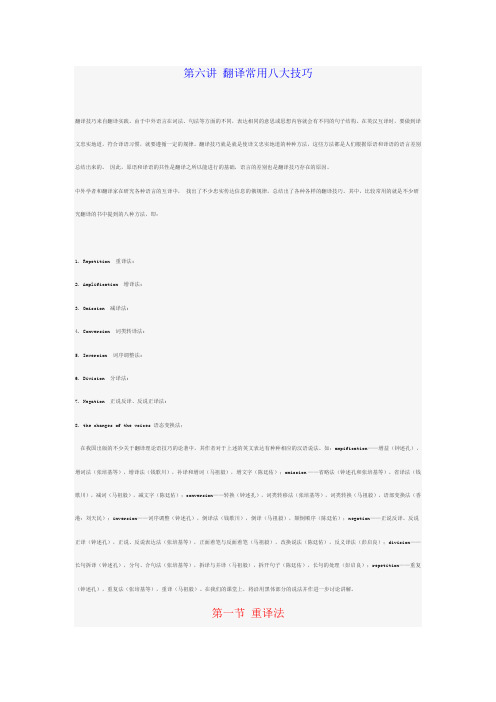
第六讲翻译常用八大技巧翻译技巧来自翻译实践。
由于中外语言在词法、句法等方面的不同,表达相同的意思或思想内容就会有不同的句子结构。
在英汉互译时,要做到译文忠实地道,符合译语习惯,就要遵循一定的规律。
翻译技巧就是就是使译文忠实地道的种种方法,这些方法都是人们根据原语和译语的语言差别总结出来的。
因此,原语和译语的共性是翻译之所以能进行的基础,语言的差别也是翻译技巧存在的原因。
中外学者和翻译家在研究各种语言的互译中,找出了不少忠实传达信息的俄规律,总结出了各种各样的翻译技巧。
其中,比较常用的就是不少研究翻译的书中提到的八种方法,即:1. Repetition 重译法;2. Amplification 增译法;3. Omission 减译法;4. Conversion 词类转译法;5. Inversion 词序调整法;6. Division 分译法;7. Negation 正说反译、反说正译法;8. the changes of the voices 语态变换法;在我国出版的不少关于翻译理论语技巧的论著中,其作者对于上述的英文表达有种种相应的汉语说法。
如:ampification——增益(钟述孔),增词法(张培基等),增译法(钱歌川),补译和增词(马祖毅),增文字(陈廷佑);omission ——省略法(钟述孔和张培基等),省译法(钱歌川),减词(马祖毅),减文字(陈廷佑);conversion——转换(钟述孔),词类转移法(张培基等),词类转换(马祖毅),语部变换法(香港:刘天民);inversion——词序调整(钟述孔),倒译法(钱歌川),倒译(马祖毅),颠倒顺序(陈廷佑);negation——正说反译、反说正译(钟述孔),正说、反说表达法(张培基等),正面着笔与反面着笔(马祖毅),改换说法(陈廷佑),反义译法(彭启良);division——长句拆译(钟述孔),分句、合句法(张培基等),拆译与并译(马祖毅),拆开句子(陈廷佑),长句的处理(彭启良);repetition——重复(钟述孔),重复法(张培基等),重译(马祖毅)。
英语翻译八大方法
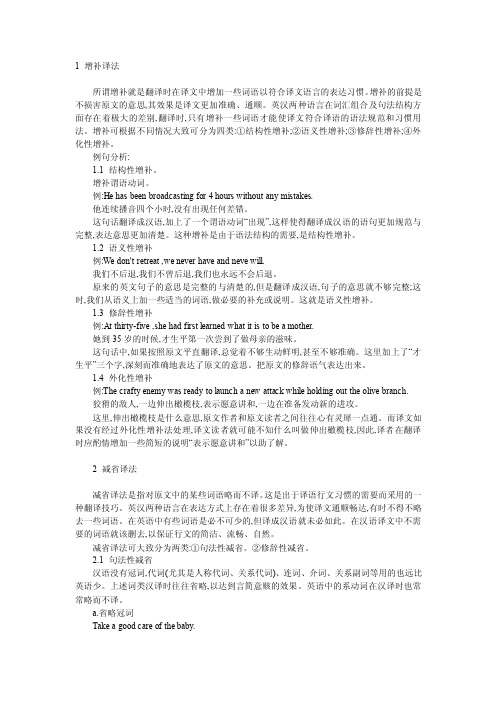
1 增补译法所谓增补就是翻译时在译文中增加一些词语以符合译文语言的表达习惯。
增补的前提是不损害原文的意思,其效果是译文更加准确、通顺。
英汉两种语言在词汇组合及句法结构方面存在着极大的差别,翻译时,只有增补一些词语才能使译文符合译语的语法规范和习惯用法。
增补可根据不同情况大致可分为四类:①结构性增补;②语义性增补;③修辞性增补;④外化性增补。
例句分析:1.1 结构性增补。
增补谓语动词。
例:He has been broadcasting for 4 hours without any mistakes.他连续播音四个小时,没有出现任何差错。
这句话翻译成汉语,加上了一个谓语动词“出现”,这样使得翻译成汉语的语句更加规范与完整,表达意思更加清楚。
这种增补是由于语法结构的需要,是结构性增补。
1.2 语义性增补例:We don't retreat ,we never have and neve will.我们不后退,我们不曾后退,我们也永远不会后退。
原来的英文句子的意思是完整的与清楚的,但是翻译成汉语,句子的意思就不够完整;这时,我们从语义上加一些适当的词语,做必要的补充或说明。
这就是语义性增补。
1.3 修辞性增补例:At thirty-five ,she had first learned what it is to be a mother.她到35岁的时候,才生平第一次尝到了做母亲的滋味。
这句话中,如果按照原文平直翻译,总觉着不够生动鲜明,甚至不够准确。
这里加上了“才生平”三个字,深刻而准确地表达了原文的意思。
把原文的修辞语气表达出来。
1.4 外化性增补例:The crafty enemy was ready to launch a new attack while holding out the olive branch.狡猾的敌人,一边伸出橄榄枝,表示愿意讲和,一边在准备发动新的进攻。
这里,伸出橄榄枝是什么意思,原文作者和原文读者之间往往心有灵犀一点通。
翻译常用的八种技巧

翻译常用的八种技巧1.增译法、增词法:amplification2.重译法、重复法:repetition3.省译法、减词法:omission4.词性转换法、词类转移法:conversion5.正说反译、反说正译法:negation6.语态变换法:the change of the voices7.分译法、分句法(OPP:合句法):division8.语序调整法、词序调整法(顺序法与逆序法)inversion增词法译文中添加一些原文没有的词句,表面上看似不忠实于原文,但仔细分析就会发现这些增加的词句所表达的意思并非无中生有,而是隐含在原文中的。
要知道,从一种语言文字向另一种语言文字转换,有时可以找到一种语言文字在另一种语言文字中的对等词,然而要想全部依赖对等词的转换来达到翻译的目的是几乎不可能的。
不同语言文字所持有的习惯决定了必须根据其中一种语言文字的习惯来适当地增词(或减词)达到语言交际的目的。
如果机械地按照字面意义直译,不仅不能表达原文的思想,精神与形象,而且还会使译文前后矛盾,闹出笑话。
例1 听到你平安的消息,非常高兴!译文: I was very glad on hearing that you were in safety!例2对不起,打扰一下!译文: Excuse me for interrupting you!(增补作宾语的代词you)例3 Histories make men wise; poems witty; the mathematics subtle; natural philosophy deep; moral grave; logic and rhetoric able to contend.译文:读史使人明智,读诗使人灵秀,数学使人周密,科学使人深刻,伦理使人庄重,逻辑修辞之学使人善辩。
(译文中添补了谓语和宾语:增词法;重译法)例4:We won’t retreat, we never have and never will.译文:我们不后退,我们从来没有后退过,我们将来也绝不后退。
翻译技巧汉译英的八大要点
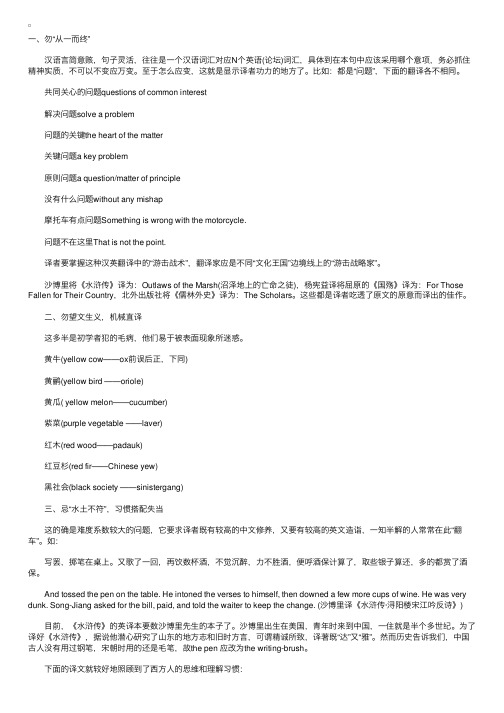
⼀、勿“从⼀⽽终” 汉语⾔简意赅,句⼦灵活,往往是⼀个汉语词汇对应N个英语(论坛)词汇,具体到在本句中应该采⽤哪个意项,务必抓住精神实质,不可以不变应万变。
⾄于怎么应变,这就是显⽰译者功⼒的地⽅了。
⽐如:都是“问题”,下⾯的翻译各不相同。
共同关⼼的问题questions of common interest 解决问题solve a problem 问题的关键the heart of the matter 关键问题a key problem 原则问题a question/matter of principle 没有什么问题without any mishap 摩托车有点问题Something is wrong with the motorcycle. 问题不在这⾥That is not the point. 译者要掌握这种汉英翻译中的“游击战术”,翻译家应是不同“⽂化王国”边境线上的“游击战略家”。
沙博⾥将《⽔浒传》译为:Outlaws of the Marsh(沼泽地上的亡命之徒),杨宪益译将屈原的《国殇》译为:For Those Fallen for Their Country,北外出版社将《儒林外史》译为:The Scholars。
这些都是译者吃透了原⽂的原意⽽译出的佳作。
⼆、勿望⽂⽣义,机械直译 这多半是初学者犯的⽑病,他们易于被表⾯现象所迷惑。
黄⽜(yellow cow——ox前误后正,下同) 黄鹂(yellow bird ——oriole) 黄⽠( yellow melon——cucumber) 紫菜(purple vegetable ——laver) 红⽊(red wood——padauk) 红⾖杉(red fir——Chinese yew) ⿊社会(black society ——sinistergang) 三、忌“⽔⼟不符”,习惯搭配失当 这的确是难度系数较⼤的问题,它要求译者既有较⾼的中⽂修养,⼜要有较⾼的英⽂造诣,⼀知半解的⼈常常在此“翻车”。
翻译的八大技巧

翻译的八大技巧翻译是一项技术活,英语好的人不见得翻译水平高,翻译的提高需要的是大家真正拿题进行反复操练,只有练习才能发现自己的问题,在操练中也可以学习借鉴一些翻译技巧,能对一些长难句有更进一步的理解。
翻译水平会是循序渐进在不断练习过程中提高的。
翻译要加强练习,争取能在后期进行翻译时更加顺手。
都教授就翻译技巧举例子进行说明。
翻译的原文和译文在语义上是不能有偏差的,但由于中英文的语言差异、表达习惯不同,在实际翻译过程中,需要对译文进行一些处理,以期更符合译入语的表达习惯。
一、增译主语由于英文表达习惯,常常用一些抽象名词作为主语,而中文的表达习惯则需要把抽象变为具体;英文中常常会为了避免重复而多用介词,中文则不怕重复,一个词会用上好几遍;英语中的复数名词译为汉语时,常常加入这些、各种、种种等,要视具体语境情况而定。
The intimacy between them can be seen easily.他们之间的亲密关系很容易就能看出来。
He did not give us satisfied answer; this made us angry.他并没有给出我们满意的答复,这种态度使得我们非常生气。
There are solutions proposed to solve the public problem.针对这一公共问题,提出了种种解决方案。
二、增译谓语英语中出现两个或多个相同谓语时,常常会省略,以使句子不那么赘余。
而中文中则要译出来,使其表达更加地道;英文中的介词短语译为中文时往往要增译动词;有些英语中的名词在译为中文时要加入相应的动词,使其意义更加完整,表达更加明确。
We went to Xiamen this week, Shenzhen next week.我们这周去厦门,下周去深圳。
Technology of behavior研究行为的科学技术;impulse for unification追求统一的冲动。
翻译笔记之八大技巧
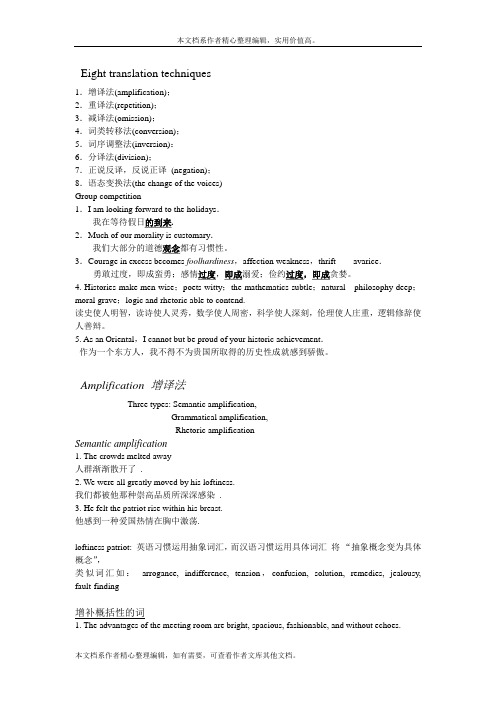
Eight translation techniques1.增译法(amplification);2.重译法(repetition);3.减译法(omission);4.词类转移法(conversion);5.词序调整法(inversion):6.分译法(division);7.正说反译,反说正译(negation);8.语态变换法(the change of the voices)Group competition1.I am looking forward to the holidays.我在等待假日的到来.2.Much of our morality is customary.我们大部分的道德观念都有习惯性。
3.Courage in excess becomes foolhardiness,affection weakness,thrift avarice.勇敢过度,即成蛮勇;感情过度,即成溺爱;俭约过度,即成贪婪。
4. Histories make men wise;poets witty;the mathematics subtle;natural philosophy deep;moral grave;logic and rhetoric able to contend.读史使人明智,读诗使人灵秀,数学使人周密,科学使人深刻,伦理使人庄重,逻辑修辞使人善辩。
5. As an Oriental,I cannot but be proud of your historic achievement.作为一个东方人,我不得不为贵国所取得的历史性成就感到骄傲。
Amplification 增译法Three types: Semantic amplification,Grammatical amplification,Rhetoric amplificationSemantic amplification1. The crowds melted away人群渐渐散开了.2. We were all greatly moved by his loftiness.我们都被他那种崇高品质所深深感染.3. He felt the patriot rise within his breast.他感到一种爱国热情在胸中激荡.loftiness patriot: 英语习惯运用抽象词汇,而汉语习惯运用具体词汇将“抽象概念变为具体概念”,类似词汇如:arrogance, indifference, tension,confusion, solution, remedies, jealousy, fault-finding增补概括性的词1. The advantages of the meeting room are bright, spacious, fashionable, and without echoes.这个会议室有四大优点:明亮、宽敞、时髦、无回声。
翻译常用的八种翻译技巧

翻译常用的八种翻译技巧一.重译法1.We have to analyze and solve problems.2.I have finished my assigned work ahead of time, so has he.3.Ignorance is the mother of fear as well as admiration.4.大家庭有大家庭的难处。
5.促进政党关系,民族关系,宗教关系,阶层关系,海内外同胞关系的和谐,对于促进团结、凝聚力量具有不可替代的作用。
二.增译法1. I am looking forward to the holidays.2. Much of our morality is customary.3. 虚心使人进步,骄傲使人落后。
4. 小不忍则乱大谋。
三.减译法1. Mr. Bingley was good-looking and gentle-like.2. Sunday is the day when I am least busy.3.中国绝不会做损人利己,以邻为壑的事情。
4.发展为了人民,发展依靠人民,发展成果由人民共享。
四.词类转换法1. In those years the Republicans were in.2. His real mission in life was to contribute, in one way or another, to the overthrow of capitalist society.3. Independent observers have commented favorably on the achievements you have made in this direction.4. 一定要少说空话,多做工作。
5.徐悲鸿画马画得特别好。
五.词序调整法1. He is not happy, though he is rich.2. But it is too late to try for strength now through nourishment.3. 能源,交通,通信等基础设施和重点工程建设成效显著。
汉译英的常用技巧

第二节 合 句 译 法 将下列句子译成英语,注意使用合句译法
(1)即使是最好的厨师,有时也会做出不好的菜来。 (2)门前放着一堆雨伞,少数也有十几把,五颜六色,大小 不一。 (3)在课堂上,他挥洒自如,海阔天空,旁征博引。 (4)听众听了他的演说,非常感动,全体表示支持这个建议。 (5)知道辜鸿铭这个名字的人,首先想到的,是他的那根在 民国以后的北平知识界里堪称独一无二的辫子。
第五节 补 全 译 法
将下列句子译成英语,注意使用补全译法。
(1)希望能够有越来越多的人学习汉语,了解中 国 文化。 (2)热烈欢迎各国游客参观故宫。 (3)在快速阅读中,主要应掌握全文的大意。 (4)估计班上大概会有80%的人通过期末考试。 (5)当前能源问题日益突出,直接影响到世界经 济 的稳定与繁荣。
第四节 换 序 译 法
译文
(1) Followed by a group of fans, the star finally came. (2) The purpose of the organization is to help those out of work reemployed. (3) It is necessary for everybody, especially the growing children and teenagers, to preserve their eyesight. (4) So kind were the teachers that the students shed tears when they graduated. (5) As early as 1649, Ohio made a decision that schools must be established in every town having 50 households or more.
翻译常用的八种技巧

翻译常用的八种技巧一、常用的翻译技巧1. 重复法(repetition)2. 增译法(amplification)3. 减译法(omission)4. 词类转移法(conversion)5. 词序调整法(inversion)6. 分译法(division)7. 正说反译, 反说正译法(negation)8. 语态变换法(the change of the voices)1. 重复法汉语重复,英译时也重复;根据两种语言各自的习惯用法,以不同的表达方式进行重复,这种重复通常是为了传达原文的生动性.We have to analyze and solve problems.我们要分析问题,解决问题。
Let’s revise our safety and sanitary regulations.我们来修改安全规则和卫生规则吧。
Gentlemen may cry, peace, peace --- but there is no peace.先生们尽管可以高呼和平,和平!但是依然没有和平。
Nels had it all written out neatly.纳尔斯把它写得清清楚楚。
青青河边草, 郁郁园中柳。
Green grows the grass upon the bank,The willow shoots are long and lank.2. 增译法为了使译文忠实地表达原文的意思与风格并使译文合乎表达习惯,必须增加一些词语,这就叫增译法.增词义增加虚词为多,也可酌量增加实词。
英译汉时经常增加的词有结构词、数量词、概念词、语气词等。
从增补的功能来看,可以分为结构增补、意义增补和修辞增补。
I am looking forward to the holidays.我们等待假日的到来。
Much of our morality is customary.我们大部分的道德观念都有习惯性。
Reading makes a full man; conference a ready man; and writing an exact man.读书使人充实,讨论使人机智,笔记使人精确。
翻译常用之八大技omission

要点二
正反表达(Positive and Negative …
正反表达是指在翻译时,根据目标语言的表达习惯和读者 的理解需求,将原文中的肯定表达转换为否定表达或将否 定表达转换为肯定表达。正反表达常用于处理英语中的双 重否定和汉语中的肯定与否定对等方面。
02
省略技巧
省略主语
当主语是显而易见的或已经在上下文中明确时, 可以省略主语。
07
重复技巧
重复名词
为了明确或强调某个概念或事物,可 以重复使用该名词,例如在科技文本 中,为了强调某个设备或技术的重要 性,可以多次提及该名词。
在文学作品中,重复名词也可以起到 修辞的效果,例如反复使用某个象征 性的物品或地名,来强化主题或情感 。
重复动词
重复动词可以用于表示连续的动作或行为,例如在描述一个过程或事件时,可以使用相同的动词进行 多次描述,以加强读者的印象。
分句性替代
01
使用从句替代
英语中的从句可以替代主句或分句中的某些成分,使表达更加紧凑和准
确。
02
使用独立主格结构替代
独立主格结构是一种非谓语动词的特殊形式,可以用来替代某些从句或
分句,使译文更加简洁和流畅。
03
使用并列句替代
并列句是由并列连词连接的两个或两个以上的简单句。在翻译中,可以
使用并列句来替代某些复杂句或复合句,使译文更加清晰和易于理解。
增加动词还可以使译文更加生动形象,增强表达力。例 如,在翻译“She walked into the room with a smile on her face.”这句话时,如果只译为“她走进房间, 脸上带着微笑。”,可能会显得比较平淡。而增加动词 “洋溢”,将其译为“她走进房间,脸上洋溢着微 笑。”,则可以使译文更加生动形象。
英汉互译八种技巧
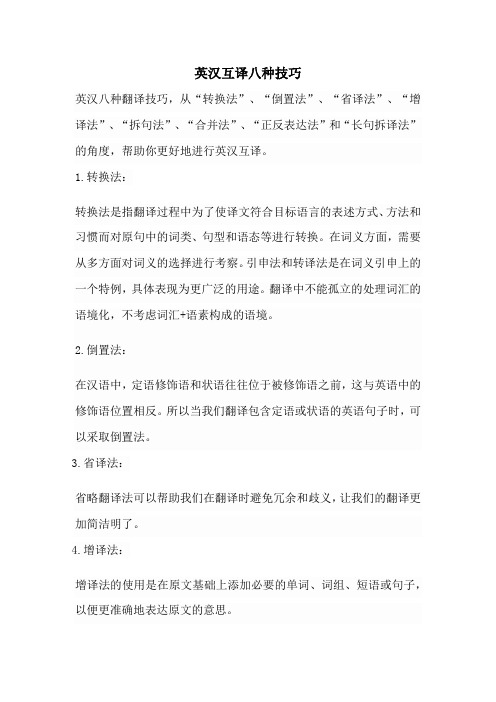
英汉互译八种技巧英汉八种翻译技巧,从“转换法”、“倒置法”、“省译法”、“增译法”、“拆句法”、“合并法”、“正反表达法”和“长句拆译法”的角度,帮助你更好地进行英汉互译。
1.转换法:转换法是指翻译过程中为了使译文符合目标语言的表述方式、方法和习惯而对原句中的词类、句型和语态等进行转换。
在词义方面,需要从多方面对词义的选择进行考察。
引申法和转译法是在词义引申上的一个特例,具体表现为更广泛的用途。
翻译中不能孤立的处理词汇的语境化,不考虑词汇+语素构成的语境。
2.倒置法:在汉语中,定语修饰语和状语往往位于被修饰语之前,这与英语中的修饰语位置相反。
所以当我们翻译包含定语或状语的英语句子时,可以采取倒置法。
3.省译法:省略翻译法可以帮助我们在翻译时避免冗余和歧义,让我们的翻译更加简洁明了。
4.增译法:增译法的使用是在原文基础上添加必要的单词、词组、短语或句子,以便更准确地表达原文的意思。
5.拆句法:当我们面对长而复杂的英语句子时,可以尝试使用拆句法。
这种方法可以帮助我们更好地理解和翻译每一个小句子,从而使整体翻译更加流畅。
6.合并法:与拆句法相反,合并法是将几个短句子合并成一个长句子。
这种翻译技巧通常用于处理英语中的复合句。
通过合并法,我们可以使译文更加紧凑、连贯。
7.正反表达法:有时,英语中的正说可以采用反译的方法,反之亦然。
这种方法可以帮助我们更好地适应不同语言的表达方式和习惯。
8.长句拆译法:对于长而复杂的英语句子,我们可以尝试将其拆分成几个小句子,以便更好地理解和翻译。
这种方法可以帮助我们理清句子的结构和层次,使整体翻译更加清晰明了。
- 1、下载文档前请自行甄别文档内容的完整性,平台不提供额外的编辑、内容补充、找答案等附加服务。
- 2、"仅部分预览"的文档,不可在线预览部分如存在完整性等问题,可反馈申请退款(可完整预览的文档不适用该条件!)。
- 3、如文档侵犯您的权益,请联系客服反馈,我们会尽快为您处理(人工客服工作时间:9:00-18:30)。
conceit makes one lag behind.
11
4. 交出翻译之前,必须读几遍,看看有没有要修改 的地方. 这样你才能把工作做好。 Before handing in your translation, you have to read it over and over again and see if there is anything in it to be corrected or improved. Only thus can you do your work well.
no peace. ❖ 先生们尽管可以高呼和平,和平!但是依然没有和
平。 ❖ Nels had it all written out neatly. ❖ 纳尔斯把它写得清清楚楚。
5
1. 这种人闹什么东西呢?闹名誉,闹地位,闹出风头。 What are they after? They are after name, after position, and they want to cut smart figure.
2. 大(家庭)有大(家庭)的难处。 A large family has its difficulties.
3. 天苍苍,野茫茫,风吹草低见牛羊。 The sky is blue, blue; And the steppe wide, wide; Over grass that the wind has battered low; Sheep and oxen roam.
How hard to calm the heart!
(译文2)
I seek but seek in vain,
I search and search again;
I feel so sad, so drear,
So lonely, without cheer. (许渊冲译)
7
❖ 5. 青青河边草, 郁郁园中柳。 ❖ Green grows the grass upon the bank, ❖ The willow shoots are long and lank.
man; and writing an exact man. ❖ 读书使人充实,讨论使人机智,笔记使人精确。 ❖ Histories make men wise; poets witty; the
mathematics subtle; natural philosophy deep; moral grave; logic and rhetoric able to contend. ❖ 读史使人明智,读诗使人灵秀,数学使人周密,科 学使人深刻,伦理使人庄重,逻辑修辞之学使人善 辩。
6
4. 寻寻觅觅,冷冷清请,凄凄惨惨戚戚;乍暖 还寒时侯,最难将息。
(译文1)
Seek, seek; search, search;
Cold, cold; bare, bare;
Grief, grief; cruel, cruel grief.
Now warm, then like the autumn cold again,
3
1. 重复法
1. 汉语重复,英译时也重复; 2源自 根据两种语言各自的习惯用法,以不同的表
达方式进行重复,这种重复通常是为了传达 原文的生动性.
4
❖ We have to analyze and solve problems. ❖ 我们要分析问题,解决问题。 ❖ Let’s revise our safety and sanitary regulations. ❖ 我们来修改安全规则和卫生规则吧。 ❖ Gentlemen may cry, peace, peace --- but there is
5. 只许州官放火, 不许百姓点灯。 The magistrate are free to burn down houses, while the common people are forbidden even to light lamps.
12
(One man may steal a horse, while another may not look over the hedge.)
10
1. 没有调查研究就没有发言权。 He who makes no investigation and study has no right to speak. (No investigation, no right to speak.)
2. 子曰:“学而不思则罔, 思而不学则殆。” Confucius said: “He who learns without thinking is lost. He who thinks without learning remains puzzled.”
8
2. 增译法
❖ 为了使译文忠实地表达原文的意思与风格并 使译文合乎表达习惯,必须增加一些词语,这就 叫增译法.
❖ 增词义增加虚词为多,也可酌量增加实词。 ❖ 英译汉时经常增加的词有结构词、数量词、
概念词、语气词等。 ❖ 从增补的功能来看,可以分为结构增补、意
义增补和修辞增补。
9
❖ I am looking forward to the holidays. ❖ 我们等待假日的到来。 ❖ Much of our morality is customary. ❖ 我们大部分的道德观念都有习惯性。 ❖ Reading makes a full man; conference a ready
大家好
1
翻译常用的八种技巧
主讲教师:邹和成 副教授
2
常用的翻译技巧
1. 重复法 (repetition) 2. 增译法 (amplification) 3. 减译法 (omission) 4. 词类转换法 (conversion) 5.词序调整法 (inversion) 6.正说反译, 反说正译法 (negation) 7.分译法 (division) 8. 语态 变换法 (the change of the voices)
